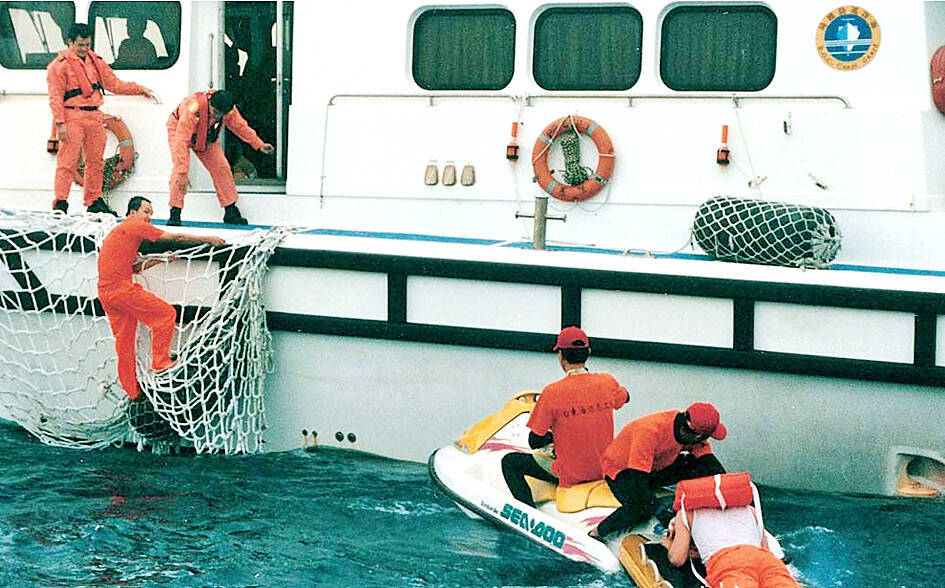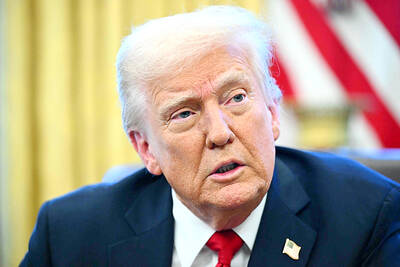Six thousand coastal patrol volunteers are to be recruited for 159 inspection offices to enhance the nation’s response to “gray zone” conflicts, Coast Guard Administration (CGA) sources said yesterday.
Volunteer teams would be established to increase the resilience of coastal defense systems in the wake of two unlawful entries attempted by Chinese over the past three months, Ocean Affairs Council Minister Kuan Bi-ling (管碧玲) said.
A former Chinese navy captain drove a motorboat into the Tamsui River (淡水河) in Taipei on the eve of the Dragon Boat Festival in June, while another Chinese man sailed in a rubber boat into the Houkeng River (後坑溪) in New Taipei City last week ahead of Mid-Autumn Festival, both claiming to be defecting to Taiwan.

Photo courtesy of the Coast Guard Administration
When the CGA was founded, five maritime volunteer teams had been established across Taiwan proper and Kinmen and Lienchiang counties with 186 volunteers, a coast guard official said, speaking on condition of anonymity.
As Beijing has been sending warplanes and vessels to harass Taiwan at its borders, making the cross-strait situation volatile, the volunteers can function as “maritime scouts” and report the discovery of unidentified ships in Taiwan’s territorial waters to the authorities, they said.
The recruitment of more maritime volunteers would help compensate for radar systems’ limited capabilities in detecting unlawful entries, especially before the construction of advanced detection technology is completed, the official said, adding that many marine enthusiasts have expressed interest in volunteering for coastal patrols.
The CGA has five branches set up for northern, central, southern and eastern Taiwan, as well as Kinmen and Lienchiang counties, collectively overseeing 159 inspection offices, most of which are located at commercial ports, fishing ports or busy estuaries, they said.
In addition to the 12 ocean service stations established in 2021, the inspection offices would also be used to incorporate a 35-person coastal patrol volunteer team, the official said.
The administration said it expects to build a coastal patrol “army” of 6,000 volunteers, with a structure of squadrons, groups and corps established for management, they said.
The volunteers would assist in preventing “gray zone” conflicts and reporting illegal behavior, such as stowaways, smuggling, illegal electrofishing or blast fishing, the official said.
They would also drive a boat or join a patrol ship to help with search-and-rescue operations or marine debris removal in line with the Ocean Affairs Council’s humanitarian aid policy and sustainable ocean plans, they added.
While the CGA plans to reinforce coastal defense by recruiting more patrol volunteers, analyses of unlawful entry incidents and stowaway cases have shown that Taiwan must bolster its self-defense no matter what an intruder’s true intentions are, the official said.
In addition to infrared thermal cameras and uncrewed aircraft, an automatic identification system (AIS) should be mandatorily installed on small ships weighing less than 20 tonnes to increase their identifiability and distinguish them from foreign vessels, they said, adding that the coast guard has been discussing the issue with other agencies, including the Ministry of Agriculture and the Ministry of Transportation and Communications.
However, more communication is needed as most fishers might not be willing to install an AIS on their ships, a fisher said, speaking on condition of anonymity.
The fishing industry is highly competitive and fisheries are considered business secrets, they said, adding that a whole year’s income could be affected if they are revealed to competitors.

AGING: As of last month, people aged 65 or older accounted for 20.06 percent of the total population and the number of couples who got married fell by 18,685 from 2024 Taiwan has surpassed South Korea as the country least willing to have children, with an annual crude birthrate of 4.62 per 1,000 people, Ministry of the Interior data showed yesterday. The nation was previously ranked the second-lowest country in terms of total fertility rate, or the average number of children a woman has in her lifetime. However, South Korea’s fertility rate began to recover from 2023, with total fertility rate rising from 0.72 and estimated to reach 0.82 to 0.85 by last year, and the crude birthrate projected at 6.7 per 1,000 people. Japan’s crude birthrate was projected to fall below six,

Conflict with Taiwan could leave China with “massive economic disruption, catastrophic military losses, significant social unrest, and devastating sanctions,” a US think tank said in a report released on Monday. The German Marshall Fund released a report titled If China Attacks Taiwan: The Consequences for China of “Minor Conflict” and “Major War” Scenarios. The report details the “massive” economic, military, social and international costs to China in the event of a minor conflict or major war with Taiwan, estimating that the Chinese People’s Liberation Army (PLA) could sustain losses of more than half of its active-duty ground forces, including 100,000 troops. Understanding Chinese

US President Donald Trump in an interview with the New York Times published on Thursday said that “it’s up to” Chinese President Xi Jinping (習近平) what China does on Taiwan, but that he would be “very unhappy” with a change in the “status quo.” “He [Xi] considers it to be a part of China, and that’s up to him what he’s going to be doing, but I’ve expressed to him that I would be very unhappy if he did that, and I don’t think he’ll do that. I hope he doesn’t do that,” Trump said. Trump made the comments in the context

SELF-DEFENSE: Tokyo has accelerated its spending goal and its defense minister said the nation needs to discuss whether it should develop nuclear-powered submarines China is ramping up objections to what it sees as Japan’s desire to acquire nuclear weapons, despite Tokyo’s longstanding renunciation of such arms, deepening another fissure in the two neighbors’ increasingly tense ties. In what appears to be a concerted effort, China’s foreign and defense ministries issued statements on Thursday condemning alleged remilitarism efforts by Tokyo. The remarks came as two of the country’s top think tanks jointly issued a 29-page report framing actions by “right-wing forces” in Japan as posing a “serious threat” to world peace. While that report did not define “right-wing forces,” the Chinese Ministry of Foreign Affairs was